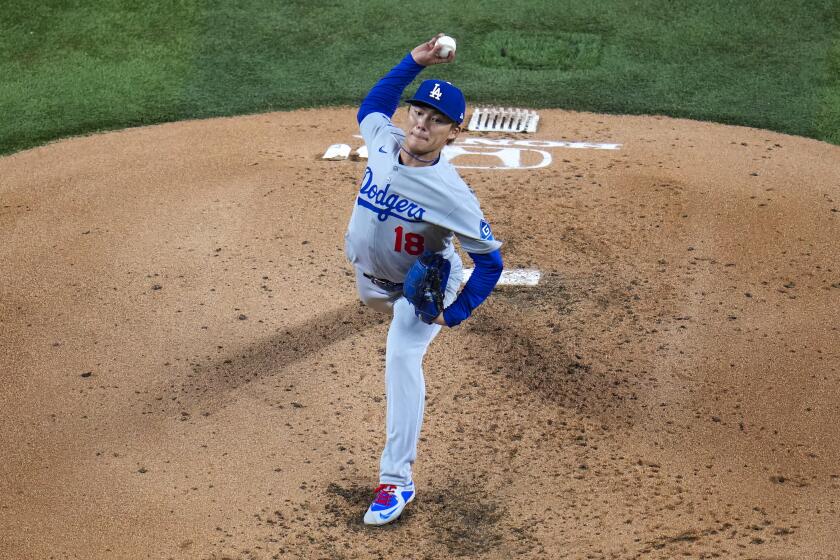The Fight Corner: Dangers of weight cutting could come into focus soon
- Share via
Hi, my name is Lance Pugmire, and welcome to our weekly boxing/MMA newsletter. This newsletter will be delivered right to your inbox every week if you sign up here. Let’s get right to the news.
Andy Foster went to Hawaii this past week and he’s bound for an Arizona resort in July, but his message is hardly about fun in the sun.
The executive officer of the California State Athletic Commission is seeking to spread the word of the dangers of weight cutting in combat sports.
After first pointing boxing and the UFC to morning weigh-ins in 2016 to limit the draining fatigue of fighters forced to remain at their often uncomfortably low weight for most of a day, Foster has compiled data and logged startling situations, hopeful his peers will follow his lead in addressing the subject.
“The culture of weight reform is coming,” Foster told the Los Angeles Times after speaking at the North American Boxing Federation convention in Honolulu on Thursday, an audience that that included several members of the World Boxing Council Board of Governors.
“We either figure it out and address it ourselves, or something will happen and it’s going to be figured out by someone else.”
The manipulation is two-pronged in its effects: fighters are taking excessive, dangerous measures to cut below their natural weight and others are rehydrating to a weight that gives them a decided advantage on fight night.
Foster’s haunting reference to a possible death that would rightfully trigger a backlash by the public and government was foremost in Foster’s mind as he presented a California commission study that has found 635 of 1,594 boxers and 598 of 1,178 mixed martial arts fighters are deemed “out of [weight] class” by packing on more than 8% of weight after their weigh-in figure.
For instance, when WBC welterweight champion Shawn Porter defended his belt in Carson in March, he gained nearly 20 pounds by fight night. Porter’s opponent, Yordenis Ugas, gained 16 pounds.
One year earlier in the same ring, featherweight champion Oscar Valdez agreed to fight challenger Scott Quigg despite Quigg missing the 126-pound limit, and Valdez, although victorious, paid for that decision by sustaining a broken jaw from Quigg’s heavy blows that has slowed the champion’s career momentum.
Similarly, Bellator’s top prospect Aaron Pico was knocked out in January by Whittier neighbor Henry Corrales after the veteran packed on 21 pounds for fight night.
Foster kept the troubling examples coming: beaten bantamweight champion TJ Doheny elevated from 121.8 at weigh-in to 137.2 pounds in his late April unification loss to Danny Roman, and super-flyweight champion Jerwin Ancajas moved from 114.2 to 130 pounds in Stockton earlier this month.
A Bellator MMA fighter, David Pacheco, topped all by inflating from 155.6 pounds in January to 187.4 pounds one night later.
“The time for action has come. While a higher purse can cause fighters to cut more weight, more lost weight is more risk,” Foster cautioned the convention as he prepares to present the evidence again at the Assn. of Boxing Commissions convention in Scottsdale, Ariz., in July. “I need the audience to listen to this, because we have two competitions – who can put on the extra weight and cut it the best and who will win the fight.
“And the weigh-in, which should not be the most dangerous part of the fight, is becoming just that.”
Foster is moving to put teeth in confronting the weight gamesmanship by notifying the athletes who come in excessively heavy on fight night that they are subject to being forced up one weight class. Thus far this year, 46 boxers and 26 MMA fighters have been moved up one weight class, Foster said. The Times learned a prominent MMA veteran fighter will make it 27 later this week.
“This problem is more prevalent in MMA due to the win-bonus money the fighters can receive,” Foster said. “Is this cheating? Not explicitly, but how much is enough? The fighters are smart – they’ll take every advantage they can legally take – and they are gaming the system, using the rules we gave them to do so.”
Foster suggested fines up to 20% of a purse on those who are clearly heavier than their fighting weight class.
“This has become a medical, fairness and competition problem, and we must pay attention to this issue,” Foster said.
Power Trio
By fighting within a month’s time, at least Deontay Wilder, Tyson Fury and Anthony Joshua are livening up the public debate about the heavyweight division.
WBC champion Wilder did his part Saturday night in Brooklyn by flattening Eastvale’s Dominic Breazeale in the first round with a massive right hand to the jaw.
“The big fights will happen. I just want you to have patience,” Wilder told reporters afterward.
Breazeale lasted into the seventh round against England’s Joshua (22-0, 21 KOs), who’s concluding preparations for his June 1 U.S. debut against California’s Andy Ruiz at Madison Square Garden.
“It’s not about what you look like, it’s a craft, a skill and what’s in your heart and your head that matters in the end,” Joshua said in defense of the pudgy underdog whose only loss was a title defeat. “Andy … can fight and box. That’s what matters. … He’s keen, he’s game and you cannot knock him. I have not underestimated him one bit.”
Fury, meanwhile, toured ESPN on Monday after detouring from a rematch with Wilder after their Dec. 1 draw at Staples Center. Fury is preparing for a June 15 date at Mandalay Bay in Las Vegas versus obscure German Tom Schwarz.
Fury had the audacity to complain Joshua and Wilder should stop worrying about “a few dollars” and get in the ring to create an entertaining round-robin of bouts, but he also admitted minutes earlier that he avoided Wilder for an immediate rematch because he believed ESPN offers a chance to generate more dollars and viewers than Showtime did in the pay-per-view draw.
Fury later informed he expects to fight Wilder again by March.
Not a light statement
Ghana’s new International Boxing Federation lightweight champion Richard Commey will make his first title defense June 28 at Pechanga Resort and Casino in Temecula versus former WBO champion Ray Beltran.
Commey (28-2, 25 knockouts) said while there was speculation he would meet NABF champion Teofimo Lopez, he opted to meet “a former champion, a guy who’s been around a long time to get my name out there and give me the credibility I need.”
Commey, 32, suffered a right knuckle injury while winning the belt in January in Texas, scrapping a planned unification with two-belt champion Vasiliy Lomachenko, who will now head to England to pursue the WBC belt against Luke Campbell.
“At the moment, I don’t know what’s going to happen after this fight. I want to come out of the fight with something great and then go from there,” Commey said when asked if he expects to meet Lopez next, with that winner headed to a four-belt unification in 2020.
The fit, powerful Commey said making his California debut on ESPN will help further his case that he’s the world’s best lightweight.
“I want to show to the world that I am one of the best in the world, and in a few months, they will all see that,” Commey said of training in Brooklyn. “I’ll keep working on everything I do.”
Until next time
Stay tuned for future newsletters. Subscribe here, and I’ll come right to your inbox. Something else you’d like to see? Email me. Or follow me on Twitter: @latimespugmire
More to Read
Go beyond the scoreboard
Get the latest on L.A.'s teams in the daily Sports Report newsletter.
You may occasionally receive promotional content from the Los Angeles Times.











